The Chamber of Demonstrations
Reconstructing the Jacobean Indoor Playhouse
Click here for a downloadable pdf of the text.
ARTIFICIAL LIGHTING IN THE EARLY MODERN ENGLISH COMMERCIAL PLAYHOUSE
Martin White
In the same way that illustrations of theatres in which the source of illumination was candle-light regularly fail to include the source of that illumination, so too do discussions of plays intended for indoor performance rarely accord the lighting any significant part in the dramatic or theatrical experience.
This research project sought to provide a greater degree of understanding of the nature, organisation and impact of artificial light in the early modern playhouse, first by creating a full-scale reconstruction, illuminating it as closely as possible in line with contemporary documentation, and through the use of new High Definition film technology capture the results. These are disseminated via DVD, a unique feature of which is the ability to move between different viewpoints in the auditorium and so witness the changing nature of the light.
Discussions of light in the indoor playhouses invariably argue that the windows would have made the use of candles necessary only at the very end of winter afternoons. The photograph of the Globe company's production of Twelfth Night at Middle Temple in 2002 shows the large windows there that would have helped illuminate performances.
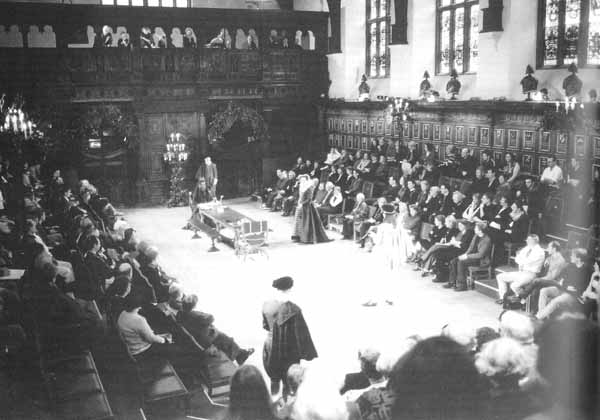
However, while the Worcester College drawings of the playhouse on which the experiment was based show a number of windows at gallery level, once the seats in front of them were occupied the light would be reduced by half, while the gallery itself significantly reduces even further the spill of that already reduced light to the stage. Robert Graves calculates that the windows, even unobstructed, would admit only 7-8 foot candles on bright afternoons (see details of light measurement below), dropping to only under one foot candle on a dim or overcast day. Moreover, Dekker's reference to playhouses with their windows shuttered suggests, even though the paucity of further evidence means there is no proof, that the playhouses might have had some device to reduce the light levels even further. We know, too, that windows were shuttered for afternoon performances in Oxford and Cambridge colleges, for example.
It is also significant that plays designed for indoors frequently stage 'dark scenes' and that, unlike in the open air playhouses where such changes in the stage state was effected through language and – presumably – appropriately mimetic performance, indoor plays clearly rely on the fact that the audience can see for themselves that it's dark.
Candles
The predominant form of general lighting in the indoor playhouse was candlelight. However, experiments that use modern candles give very misleading results. Playhouses were lit by a mixture of tallow and beeswax candles. We had our candles made by Mary Fisher, a chandler in Leeds, who dipped them, rather than rolling them, and we used a loose rather than a woven flax wick (contemporary candles also sometimes had rush wicks). The tallow was sheep's tallow, and was completely unrefined.
Measuring candlelight
 |
fig. Bleached beeswax candles, the most refined of all, the most expensive and so used rarely, such as in John Ford's stage direction in 'Tis Pity She's A Whore calling for 'wax lights' which, placed on a table, clearly indicate it is an altar. |
- The amount of light produced by a light source is known as Luminous Flux, and is measured in Lumens. The power that a light source emits in a given direction is known as Luminous intensity, and is measured in Candela: 1 Candela = 1 Lumen per steradian (= unit solid angle)
- The brightness of a surface is known as Illuminance, and is measured in Lux (Lumens per square metre), or Footcandles (Lumens per square foot): 1 Footcandle = 10.76 Lux
- A modern candle produces around 1 Candela (12.57 Lumens); a similar sized beeswax candle produces less than half a Candela (5 Lumens). Tallow candles and oil lamps produce even less. Wax candles burn 30% brighter than tallow.
How many candles?
The records of the Salisbury Court playhouse (which has in the past been associated with the Worcester College drawings) indicate that a mix of wax and tallow was used, possibly one quarter wax to three quarters tallow, resulting in a total of around 40 candles. In my experiment we burned 32 in the chandeliers above the stage, with a further ten in sconces on the pillars at the side of the stage and in the pit, rather like those employed at the Teatro Olimpico in Vicenza which might itself be a possible influence on the WC designs.
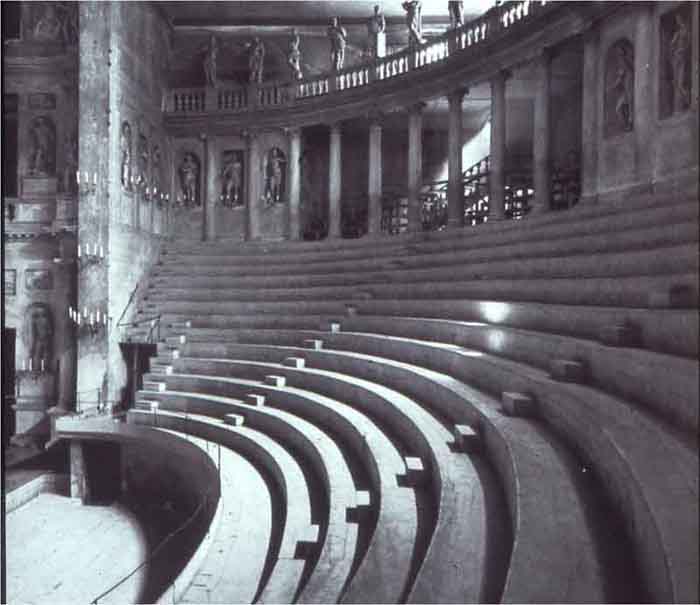
It is important to remember, however, that there is no evidence before the eighteenth century of a chandelier hung over the pit.
For a comparison of the illumination provided, we can look at a later playhouse, but one that still exists – the Drottningholm Court Theatre in Sweden.

This theatre has the following lighting positions:
- 12 candles in the footlights
- 6 pairs of wings, 10 candles behind each wing = 120 candle
- 1 pair of wings with 6 candles behind each wing = 12 candles
- 4 chandeliers in the auditorium, perhaps with 12 candles in each = 48 candles
- Probably some bracket candlesticks on the walls, say 12 candles
- Probably 2 chandeliers above the forestage, say 24 candles
This produces the following illumination:
- 12 candles as Footlights = 100 Lumens
- 24 candles in advance bar chandeliers = 200 Lumens
- 60 candles in auditorium chandeliers and brackets = 480 Lumens
- 132 candles on poles in wings = 1060 Lumens
In practical terms, while the face of an actor standing 1 m upstage of 5 floor-mounted beeswax candles is lit at 0.66 lux (0.06 Fc), the face of an actor standing 1 m upstage of a single floor-mounted 50 W birdie at 10% intensity is lit at 50 lux (4.6 Fc). In other words, lighting levels today are approximately 70 times greater than at Drottningholm in 1766.
Our eyes react differently to candlelight than to other forms of illumination. What is known as the Purkinje Effect means that the tendency of the peak sensitivity of the human eye is to shift toward the blue end of the spectrum at low illumination levels. This effect introduces a difference in color contrast under different levels of illumination. In bright sunlight, geranium flowers appear bright red against the dull green of their leaves, but in the same scene viewed at dusk, the contrast is reversed, with the petals appearing a dull red against paler green leaves. The eye has 2 systems of detecting light: Rods and Cones. Cone cells in the retina give us the impression of colour, and are most sensitive to yellow light; Rod cells, which are more light-sensitive (and thus more important under low levels of illumination) do not distinguish colours and respond best to green-blue light.
This can be seen clearly in the extracts on the DVD, and demonstrate in action Sir Francis Bacon's observations on the effect of candlelight on fabrics of different colours.
One thing in particular remains unresolved, however. I had expected the wax candles to smoke and smell more than they did, in line with a number of contemporary references. Indeed, I asked Mary Fisher for a second batch of tallow candles to be as unrefined as possible, just animal suet in effect, but they still failed to create a smelly fug. Guttering, however, was a problem, and demonstrated the need for attention in the act breaks.
Chandeliers
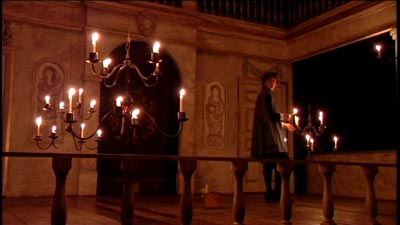
We created four elegant, branched chandeliers modelled on those shown in the Wits frontispiece (fig. 1), as, although later in date, I considered these more in line with the neoclassical nature of the playhouse than the more traditional cartwheel design, similar to those in the illustration (of a later playhouse) below (fig. 2).
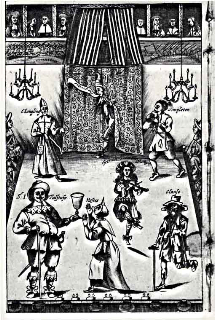
fig 1 The Wits
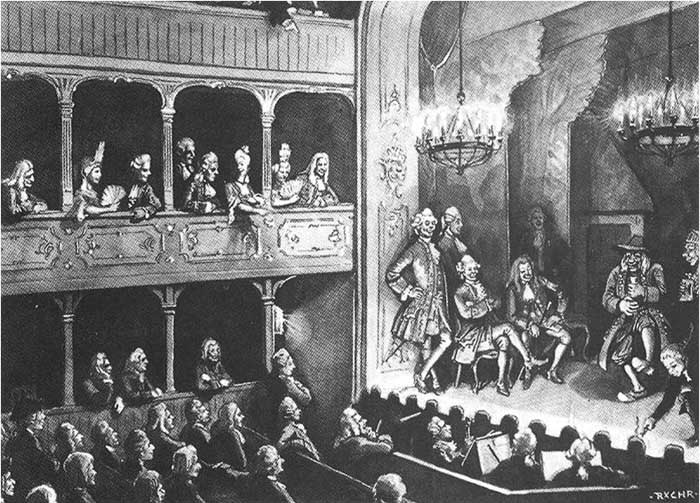
fig 2 Theatre with cartwheel chandeliers
Each of our chandeliers held eight candles. The height above the stage is crucial. We hung ours ten feet above the stage.
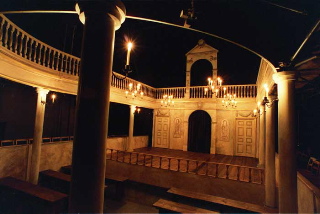
Reconstruction showing height of candles
Samuel Pepys complained of having to look through the candles when sitting on the upper seating level, and you do precisely that in the reconstruction.

Although from a later period and from France, the following illustration gives a good indication of the relationship of performer to the overhead chandeliers.

The diagram below shows the positions of the chandeliers in our reconstruction.
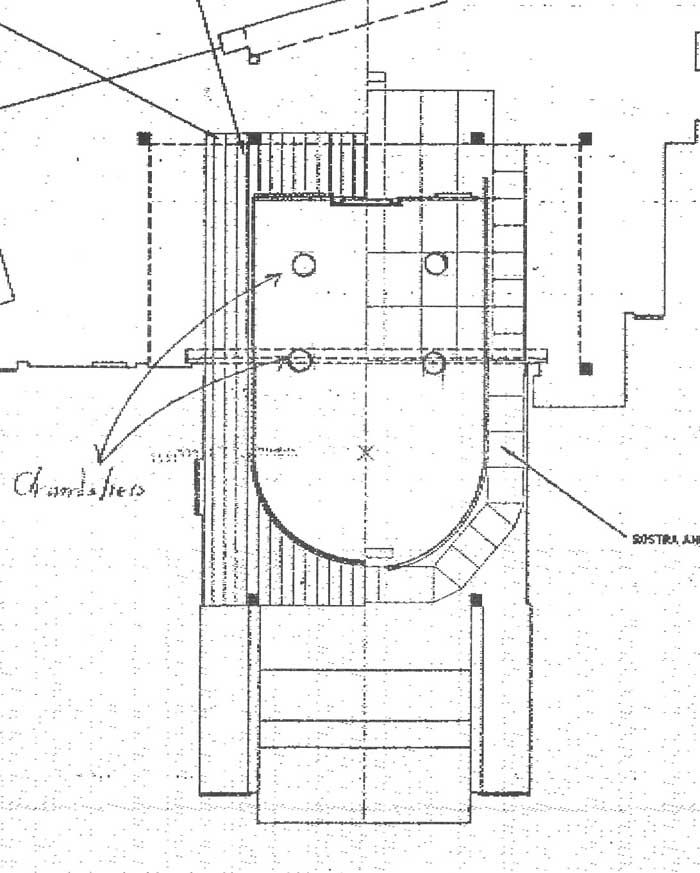
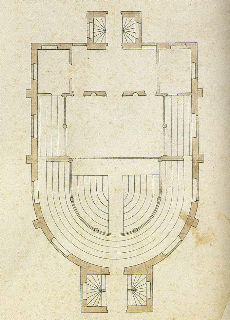
The purpose of the space shown on the original drawing between the front edge of the stage and the seating unit became clear to me as I realised that actors are illuminated by chandeliers that hang in front of, rather than above, them, and allowed the chandeliers to be suspended slightly forward of the stage rail, but with no audience beneath.
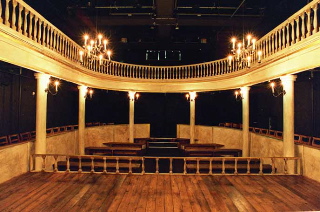
The chandeliers were lowered to the stage and, when all the candles were alight, raised to the playing position (shown on The Changeling extract). However, there is evidence from the Restoration period that chandeliers were raised higher than their normal position during the action in order to further dim the stage, and we also did this in our Duchess of Malfi extract (they are raised as Bosola, extinguishing the stage candles, informs the Duchess that her brother will only see her in the dark). We raised them too in preparation for the murder of Bergetto in Tis Pity She's A Whore. Above about twelve feet the impact of the chandeliers in terms of lighting the actors was significantly reduced.
It is significant, given the time it takes to effect changes of candlelight, that scenes in which light plays a particular role in setting mood or a key factor in the narrative are frequently grouped together in a specific sequence. In 'Tis Pity She's A Whore for example the first intimations of impending darkness are given in 3.5 with various references to 'this very night' (8), 'this night' (13), etc. The following scene (3.6) is specific in its lighting: 'Enter the Friar sitting in a chair, Annabella kneeling and whispering to him; a table before him and wax lights'. The removal of these (particularly bright) candles will make the stage appear to darken (modern lighting designers still raise the light level before dark scenes to effect a greater contrast), while raising the chandeliers and extinguishing the stage candles will produce a significant change for 3.7 (see DVD extract). 3.8 is a short scene (possibly played above with a lantern to pull focus and illuminate faces) before returning to the main stage for the last scene of the act. Significantly, in my view, the scene that opens the fourth act is a feast to celebrate the marriage of Soranzo and Annabella, in which Ford (who knew the playhouse and its resources well) provides full opportunity to relight candles and, if necessary, unshutter any windows. In the study of scenes in which changes of light play a significant role (the extract from The Duchess of Malfi is another) it is essential to examine exactly where they come in the structure of the performance.
Footlights
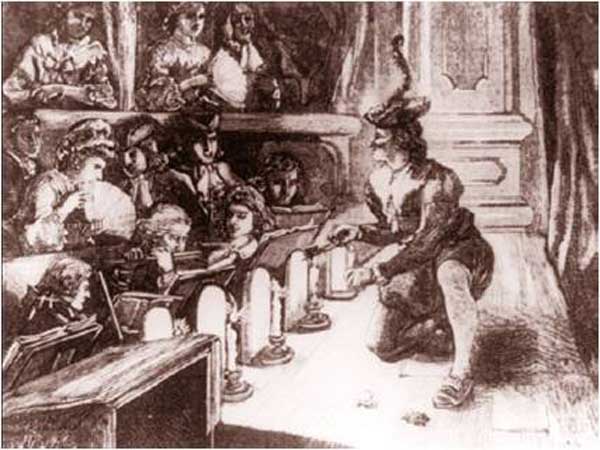
Although the Wits frontispiece shows a row of (oil) lamps along the front edge of the stage there is no evidence of their use before the Restoration playhouses (as shown above). At the WC playhouse a rail along the front edge of the stage occupies their position, and references to performers moving between stage and auditorium at the Blackfriars (The Knight of the Burning Pestle) for example, suggests they were not employed their either.
Mobile Lighting
Although, as I think the extracts on the DVD illustrate, raising and lowering the chandeliers effects a significant lighting change, the state remains overall the same across the stage. This makes the use of mobile lighting instruments particularly necessary and effective. We worked with three main forms of mobile lighting: candles, lanterns and torches, but as Robert Graves points out:
'...the major obstacle in attempting to reconstruct the artificial illumination of the early drama is that nearly every light could be and was confused with others. Torches and tapers were sometimes called candles, large candles were called torches, and even tapers [usually single, thin ropes dipped in tallow and used mainly in bedrooms] were called lanterns. Moreover, all of these instruments were frequently identified simply by the general term 'light' (Lighting the Shakespearean Stage, 1567-1642, Southern Illinois University Press, 1999, p. 23. Graves' book is essential reading.)
The DVD extracts are designed to be largely self-explanatory, but there are one or two specific points to make:
Candles
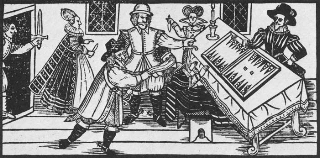
Frontispiece from Arden of Faversham
Candles are the most common hand-held light, and, though not as unstable as a taper, still susceptible to being extinguished by drafts from curtains or doors. Used as a signifier in scenes, but also, as is particularly evident in the extracts from Love's Sacrifice (in Use of the Stage, and illuminating the chess board and providing stage focus) and The Guardian (in Use of Light, illuminating crucial moments in the scene) candles enabled aspects of the action to be emphasised, or parts of the stage to be given greater significance.
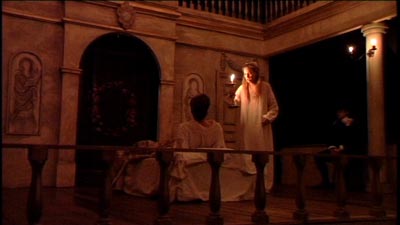
Love's Sacrifice
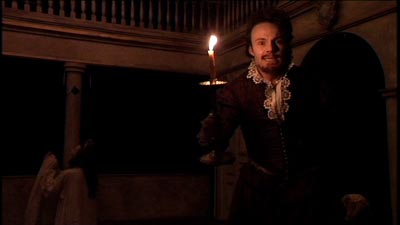
The Guardian
Lanterns
Their use commonly denotes an exterior, as in the street scene we have chosen from 'Tis Pity She's A Whore. The 'dark lantern' that the murderer, Grimaldi, carries at the opening of the scene was designed so that the user could by closing a door over the horn window block out the light from the candle inside without extinguishing it completely. Ours was made by David Fisher and modelled directly on the lantern said to have been carried by Guy Fawkes when he was arrested.
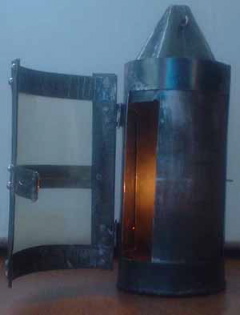
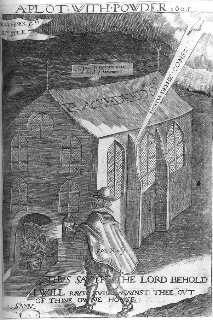
The use of lanterns in this particular scene (played with the chandeliers raised to their highest level) allows the discovery of the mortal wound to Bergetto (the scene is clearly based on the death of Mercutio) to be delayed until the closely held lantern reveals that it is blood, not sweat or urine, on Richardetto's hands, and that prompts the cold realisation that Bergetto has been murdered.
The lantern (or a candle) was also useful in calling focus to an actor using the upper level. The extract from Love's Sacrifice (in Use of the Stage) demonstrates this.
Torches
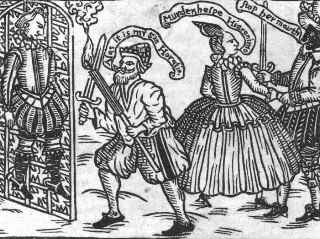
Frontispiece from Kyd's The Spanish Tragedy
These are the most dramatic hand-held instruments, as the scene from The Duchess of Malfi demonstrates. Here, as well as providing vivid contrast with the overall darkness on stage (chandeliers at full height, side candles extinguished) they allow Bosola to illuminate the hand dropped by the Duchess – that as many of the audience as possible must see – and to take our attention to the figures (as she believes them to be) of her dead husband and children, placed in the recess at the rear of the stage.
For further detailed analysis that can be set alongside the extracts on the DVD, see my Renaissance Drama in Action (Routledge, 1998), especially pp. 148-151 and 170-176.